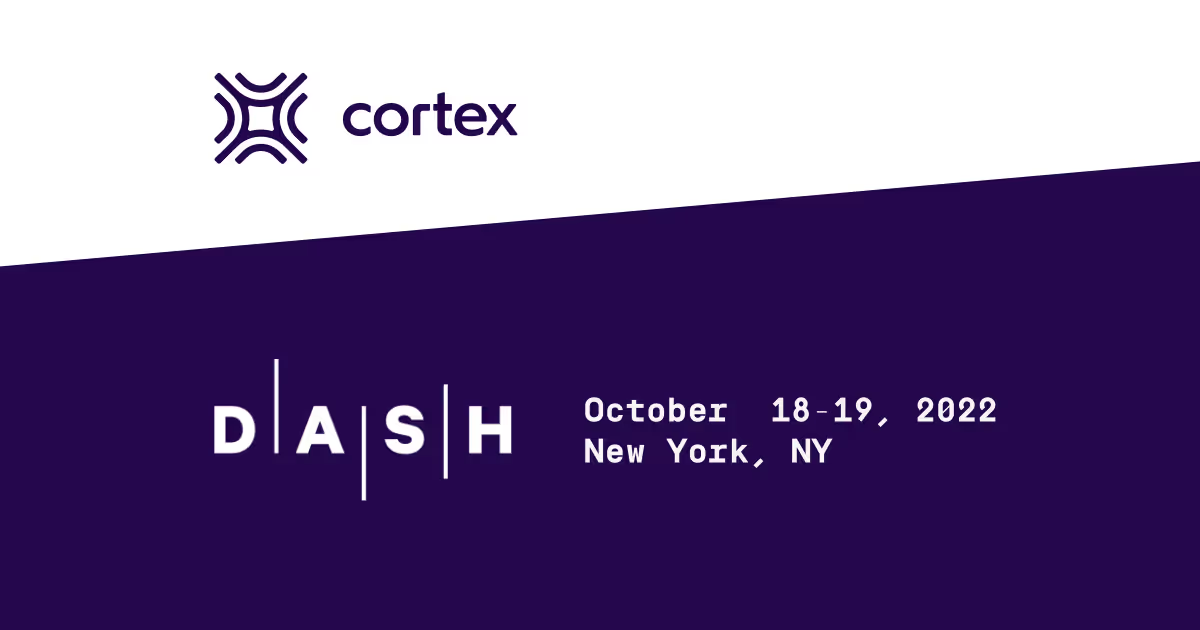With Datadog’s Dash conference right around the corner, we at Cortex have been thinking a lot about best practices for observability. To get the most out of an application performance monitoring (APM) vendor like Datadog, you want to make sure monitoring and observability are built into launch and production readiness checklists. From standardizing on naming, defining key metrics, and preparing your on-call team, observability can’t be an afterthought — service owners should be encouraged to take a proactive approach to monitoring.
More specifically, with any APM product, standardizing naming conventions is crucial, especially if you’re monitoring microservices across multiple environments. The service’s name in your Git repo should match its name in the Kubernetes container, which should also match its name within your APM instance. This kind of standardization will ultimately enable you to build automation and tooling around your services. Similarly, you want to use standard tagging conventions across environments. This makes it easier later on to establish correlations across different platforms and distinct tools.
Additionally, when you’re first launching a service, you might not immediately know what your service level objectives (SLOs) should be, but you probably know what your service-level indicators (SLIs) should be: error rate, latency, and throughput to name a few. Regardless of whether you have SLOs established, hitting the ground running with clear SLIs will ensure a smooth production ready launch.
Finally, it’s crucial for SREs to have visibility into adoption of these standards so they can ensure services are actively reporting logs, metrics, and traces. SRE teams also need to ensure that the monitoring of these data points is proactive and monitors are set up with the right warning and alerting thresholds, and escalation policies. This visibility is part of why standard naming and tagging conventions are so important to good observability practices.
Standardization and best practices should be incorporated into your observability tool from the beginning, so that you can make the most out of your observability platform and effectively respond to incidents.
Monitoring with Datadog and Cortex
As a Datadog technical integration partner, Cortex is uniquely equipped to augment your rollout or general usage of Datadog so that your teams get the most value out of it. When you’re creating a new service, Cortex automates your production readiness checklist and confirms that the service has monitors set up, APM enabled, and is assigned the right tags.
Through our integration, Cortex automatically pulls monitors and SLOS into your service catalog and continues to ensure that monitors and SLOs are configured as new services are created. Scorecards also provide visibility into aggregated views of SLOs per service and across services, and displays whether or not they are achieving their goals. A lot of this functionality relies on standard tagging conventions, but the benefit of Cortex is that it will handle most of the manual work for developers.
Through automatic discovery, all of the vital observability metrics are correlated in a single place. Cortex can pull in application summary metrics and embed Datadog graphs directly into your service catalog, providing powerful at-a-glance insights. Plus, Cortex can sync with your service dependency graph in Datadog and provide an extra layer of visibility into the libraries and infrastructure assets that your services touch, but that might not make it into Datadog tracing.
Datadog is a leading platform for observability, and Cortex enhances your Datadog experience with dynamic Scorecards and reporting. Cortex’s structured service and resource catalogs are a perfect complement to Datadog’s powerful monitoring capabilities.
Catch us at Dash
Cortex is thrilled to be a gold-level sponsor for the Dash conference, especially because so many Cortex users rely heavily on both our platform and Datadog. We’ve seen just how much more powerful Datadog is when it’s used side-by-side with Cortex. We’re excited to help folks build better production readiness checklists and help companies get the most value out of their Datadog setups.
The Dash conference is taking place on October 18th and 19th in New York City, and Cortex co-founders Anish Dhar and Ganesh Datta are both excited to attend. Plus, Ganesh will be giving a talk entitled “Still Using Spreadsheets to Track Your Services? You Need a Developer Portal” on October 19th at 1 p.m. EDT in the Partner Theater.
You can find us, along with free stickers and t-shirts, at Booth #14 on both days. We’ll also have an iPad Pro giveaway that you can enter to win when you visit us. Can’t wait to get your hands on swag? Be one of the first 50 people to schedule a demo and we’ll send you a pair of Cortex socks!
To learn more about Cortex and how we can help you make the most of your observability tools, make sure to subscribe to our blog and follow us on Twitter.





